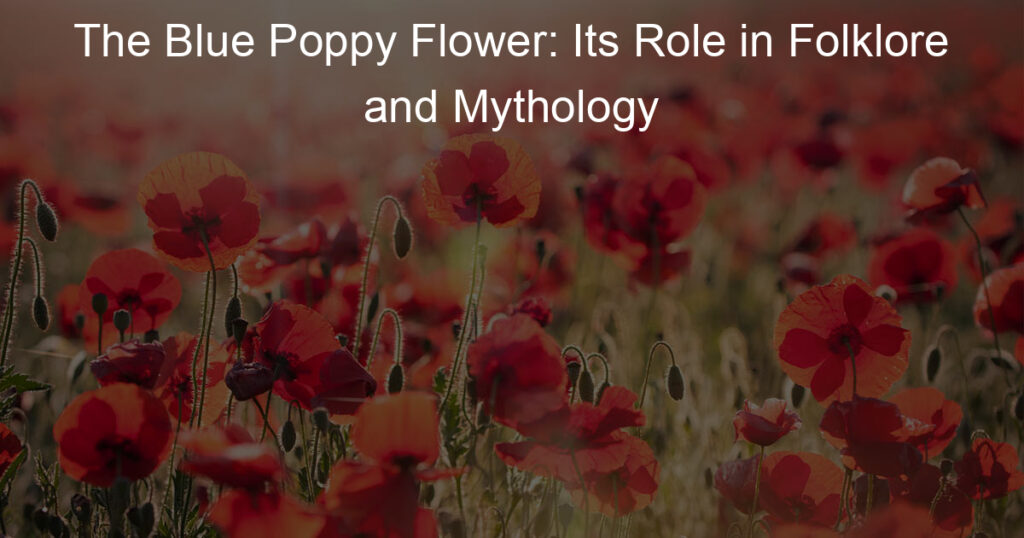If you love flowers, you’ve probably come across the blue poppy at some point. This gorgeous flower has a long history and has been featured in folklore and mythology from around the world. In this blog post, we’ll explore the meaning of the blue poppy and its role in different cultures. So grab a cup of tea and settle in for a fascinating read!
What does the poppy symbolize in ancient times?
In many ancient cultures, the poppy flower has long been symbolic of deities and immortality. The red-tipped buds of the poppy have often been associated with the remembrance of lost loved ones, as well as fears of death and dreams of life everlasting. The ancients also believed that the delicate petals of a poppy held magical powers, having the ability to protect against malicious forces and bring good luck to anyone carrying it.
Poppies have also remained popular in literature throughout the ages, playing a significant role in both Greek and Roman mythology as sacred objects signifying prosperity, joy, and good health. These beliefs have been upheld in some form or another over time, leading us to view poppies today as deeply meaningful symbols.
What is the legend of the poppy flower?
The legend of the poppy flower is one of love and sorrow. According to folklore, it began when a young man tragically lost his beloved in a battle far away. Feeling broken-hearted and desperate, he laid down to die on a hillside covered with poppies; ever after, poppies came to represent remembrance of those who have passed.
Poppy flowers have been used as symbols throughout time in countries all over the world, culminating most recently in their association with Remembrance Day ceremonies honoring those who served in WWI and WWII. The symbolism of hope and beauty amidst the darkness of loss makes this legend a beautiful reminder that we can honor the memories of our loved ones while still living our own lives.
What does the blue poppy flower symbolize?
The blue poppy flower is often connected with beauty and hope, making it a cherished symbol of peace and positivity. Its delicate petals evoke a feeling of tranquility, while its vivid hue captures feelings of pure joy.
As one of the few blue blossoms in the world, it stands out as a reminder that moments of serenity and brightness can be found even in difficult times. By admiring the simple beauty of a blue poppy flower, we bring that peace into our lives and reflect upon its hopeful message.
What are blue poppies called?
Blue poppies are often referred to as Delphinium. With bright blue petals and a charming look, these beautiful flowers have become popular over the years for decorations, floral arrangements, and more!
Their vivid color gives any garden an incredible pop of color and can create a beautiful oasis in any backyard. If you’re looking to add a bit of life and vibrancy to your outdoor space while creating a statement piece, adding some Delphinium would be an excellent choice!
What does a poppy mean in mythology?
The poppy has been associated with mythology for centuries. According to Greek mythology, poppies were believed to be a symbol of sleep and death and also gave peace and comfort to those experiencing grief or soul-weariness. In Hinduism, the poppy was often depicted as a divine flower that brought enlightenment and opened up minds to spiritual truths.
The association between poppies and death continued in the Victorian era when they became popularly associated with the remembrance of soldiers that had fallen during war. Over time, the poppy came to have many meanings, but all of them are linked by associations of peace, death, remembrance, and resurrection.
How was poppy used in ancient times?
The opium poppy has been used for centuries to treat pain and induce sleep. Its rich history dates back to ancient times when it first became a popular medicinal herb. Throughout the ages, it has been used in various cultures and societies – from Greek mythology to Mesopotamia – as an effective remedy against a wide range of illnesses. Poppy was highly praised by Hippocrates himself, who referred to it as “the most valuable of all remedies”.
Ancient Greek physicians prescribed opium poppy as an anesthetic agent, while the Chinese would commonly use it in combination with other plants as part of traditional medicines. In some cultures, people would even wear wreaths made of poppies to ward off evil spirits! These days, the poppy is still widely used in natural therapies, but its primary benefit remains effective pain relief; opium poppies are the bases for many modern analgesic drugs such as morphine and codeine.
Conclusion
The blue poppy flower has a long, storied history of being featured in folklore, myths, and cultures that span back centuries. It’s even been mentioned in works of literature, its blooms are celebrated by many past generations of people. From ancient Greece to China, the blue poppy flower has had an immense impact on culture and symbolism throughout the ages – and it continues to do so even today. All in all, we can certainly appreciate the significance of this beautiful bloom – both its vibrant color and lasting impact throughout many cultures. While this blog post only scratches the surface when it comes to exploring the mythical background of the blue poppy flower, we hopefully still gained a bit more insight into what this beloved bloom truly stands for!














